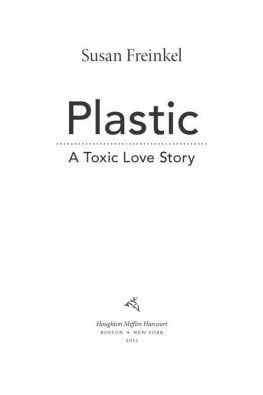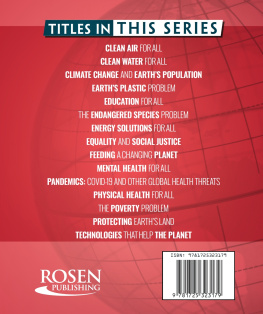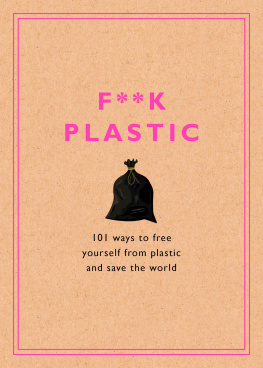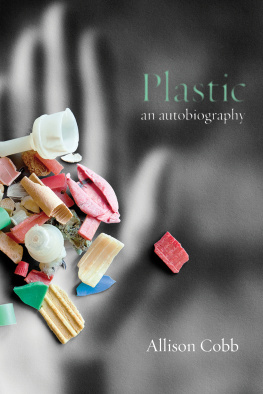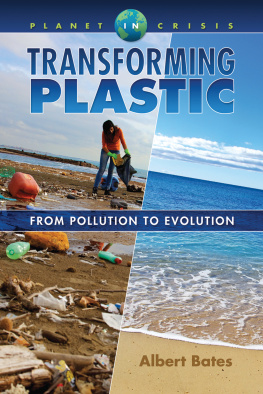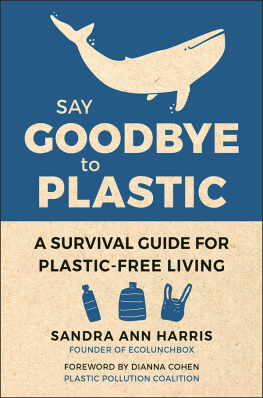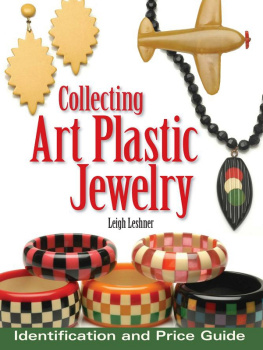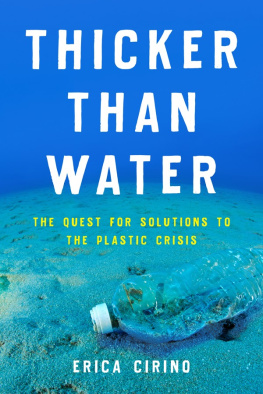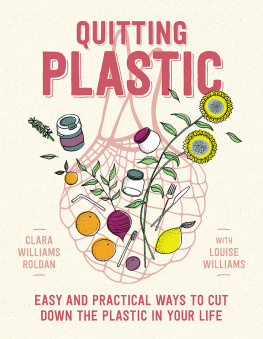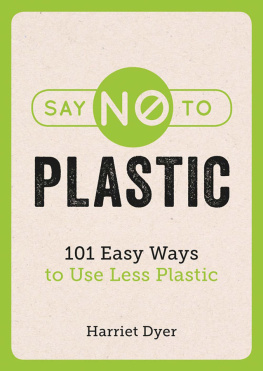Plastic
A Toxic Love Story
Susan Freinkel
Table of Contents
Houghton Mifflin Harcourt
BOSTON NEW YORK
2011
Copyright 2011 by Susan Freinkel
All rights reserved
For information about permission to reproduce selections from this book,
write to Permissions, Houghton Mifflin Harcourt Publishing Company,
215 Park Avenue South, New York, New York 10003.
www.hmhbooks.com
Library of Congress Cataloging-in-Publication Data
Freinkel, Susan, date.
Plastic : a toxic love story / Susan Freinkel.
p. cm.
Includes bibliographical references and index.
ISBN 978-0-547-15240-0
1. Plastics. I. Title.
TP 1120. F 74 2011
620.1'923dc22
2010043019
Printed in the United States of America
DOC 10 9 8 7 6 5 4 3 2 1
Excerpt from "Plastic" from Unincorporated Persons in the Late Hondo Dynasty by
Tony Hoagland. Copyright 2010 by Tony Hoagland. Reprinted with the permission
of Graywolf Press, Minneapolis, Minnesota,www.graywolfpress.org.
For Eli, Isaac, and Moriah
I wonder if it would have done any good then
If I had walked over and explained a few things to them
About Plastic?
About how it is so much easier to stretch than
human nature,
which accounts for some of the strain imposed on
the late 20th-century self...
Tony Hoagland, "Plastic"
Contents
Introduction: Plasticville
1. Improving on Nature
2. A Throne for the Common Man
3. Flitting Through Plasticville
4. "Humans Are Just a Little Plastic Now"
5. Matter Out of Place
6. Battle of the Bag
7. Closing the Loop
8. The Meaning of Green
Epilogue: A Bridge
Cast of Characters
Acknowledgments
Notes
Selected Bibliography
Index
Introduction: Plasticville
I N 1950, a Philadelphia toy company came out with a new accessory for electric-train enthusiasts: snap-together kits of plastic buildings for a place it called Plasticville, U.S.A. Sets of plastic people to populate the town were optional.
It started as a sleepy, rural place where trains might roll past red-sided barns to pull into a village with snug Cape Cod homes, a police department, a fire station, a schoolhouse, and a quaint white church with a steeple. But over the years, the product line spread into a bustling burb of housing tracts filled with two-story Colonials and split-level ranch houses and a Main Street that boasted a bank, a combination hardware store/pharmacy, a modern supermarket, a two-story hospital, and a town hall modeled on Philadelphia's historic Independence Hall. Eventually Plasticville even gained a drive-in motel, an airport, and its own TV station, WPLA.
Today, of course, we all live in Plasticville. But it wasn't clear to me just how plastic my world had become until I decided to go an entire day without touching anything plastic. The absurdity of this experiment became apparent about ten seconds into the appointed morning when I shuffled bleary-eyed into the bathroom: the toilet seat was plastic. I quickly revised my plan. I would spend the day writing down everything I touched that was plastic.
Within forty-five minutes I had filled an entire page in my Penway Composition Book (which itself had to be cataloged as partly plastic, given its synthetic binding, as did my well-sharpened no. 2 pencil, which was coated with yellow paint that contained acrylic). Here's some of what I wrote down as I made my way through my early-morning routine:
Alarm clock, mattress, heating pad, eyeglasses, toilet seat, toothbrush, toothpaste tube and cap, wallpaper, Corian counter, light switch, tablecloth, Cuisinart, electric teakettle, refrigerator handle, bag of frozen strawberries, scissors handle, yogurt container, lid for can of honey, juice pitcher, milk bottle, seltzer bottle, lid of cinnamon jar, bread bag, cellophane wrapping of box of tea, packaging of tea bag, thermos, spatula handle, bottle of dish soap, bowl, cutting board, baggies, computer, fleece sweatshirt, sports bra, yoga pants, sneakers, tub containing cat food, cup inside tub to scoop out the kibble, dog leash, Walkman, newspaper bag, stray packet of mayo on sidewalk, garbage can.
"Wow!" said my daughter, her eyes widening as she scanned the rapidly growing list.
By the end of the day I had filled four pages in my notebook. My rule was to record each item just once, even those I touched repeatedly, like the fridge handle. Otherwise I could have filled the whole notebook. As it was, the list included 196 entries, ranging from large items, like the dashboard of my minivanreally, the entire interiorto minutiae, like the oval stickers adorning the apples I cut up for lunch. Packaging, not surprisingly, made up a big part of the list.
I'd never thought of myself as having a particularly plastic-filled life. I live in a house that's nearly a hundred years old. I like natural fabrics, old furniture, food cooked from scratch. I would have said my home harbors less plastic than the average American'smainly for aesthetic reasons, not political ones. Was I kidding myself? The next day I tracked everything I touched that wasn't made of plastic. By bedtime, I had recorded 102 items in my notebook, giving me a plastic/nonplastic ratio of nearly two to one. Here's a sample from the first hour of the day:
Cotton sheets, wood floor, toilet paper, porcelain tap, strawberries, mango, granite-tile countertop, stainless steel spoon, stainless steel faucet, paper towel, cardboard egg carton, eggs, orange juice, aluminum pie plate, wool rug, glass butter dish, butter, cast-iron griddle, syrup bottle, wooden breadboard, bread, aluminum colander, ceramic plates, glasses, glass doorknob, cotton socks, wooden dining-room table, my dog's metal choke collar, dirt, leaves, twigs, sticks, grass (and if I weren't using a plastic bag, what my dog deposited amid those leaves, twigs, and grass).
Oddly, I found it harder and more boring to maintain the nonplastic list. Because I'd pledged not to count items more than once, after the first flood of entries, there wasn't that much varietyat least not when compared with the plastics catalog. Wood, wool, cotton, glass, stone, metal, food. Distilled further: animal, vegetable, mineral. Those basic categories prettymuch encompassed the items on the nonplastic list. The plastic list, by contrast, reflected a cornucopia of materials, a dazzling variety of the synthetica that has come to constitute such a huge, and yet strangely invisible, part of modern life.
Pondering the lengthy list of plastic in my surroundings, I realized I actually knew almost nothing about it. What is plastic, really? Where does it come from? How did my life become so permeated by synthetics without my even trying? Looking over the list I could see plastic products that I appreciated for making my life easier and more convenient (my wash-and-wear clothes, my appliances, that plastic bag for my dog's poop) and plastic things I knew I could just as easily do without (Styrofoam cups, sandwich baggies, my nonstick pan).
I'd never really looked hard at life in Plasticville. But news reports about toxic toys and baby bottles seemed to suggest that the costs might outweigh the benefits. I began to wonder if I'd unwittingly exposed my own children to chemicals that could affect their development and health. That hard-plastic water bottle I'd included in my daughter's lunch since kindergarten has been shown to leach a chemical that mimics estrogen. Was that why she'd sprouted breast buds at nine? Other questions quickly followed. What was happening to the plastic things I diligently dropped into my recycling bin? Were they actually being recycled? Or were my discards ending up far away in the ocean in vast currents of plastic trash? Were there seals somewhere choking on my plastic bottle tops? Should I quit using plastic shopping bags? Would that soda bottle really outlive my children and me? Did it matter? Should I care? What does it really mean to live in Plasticville?

